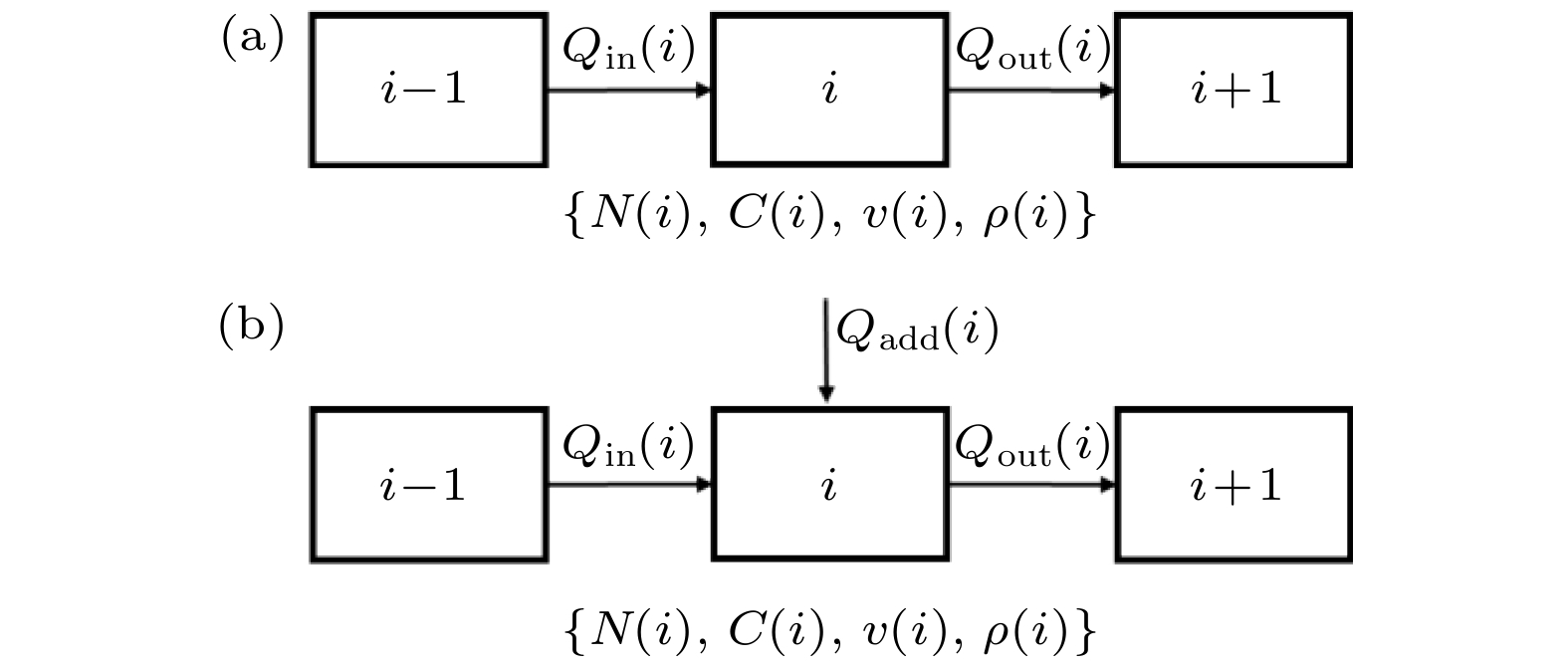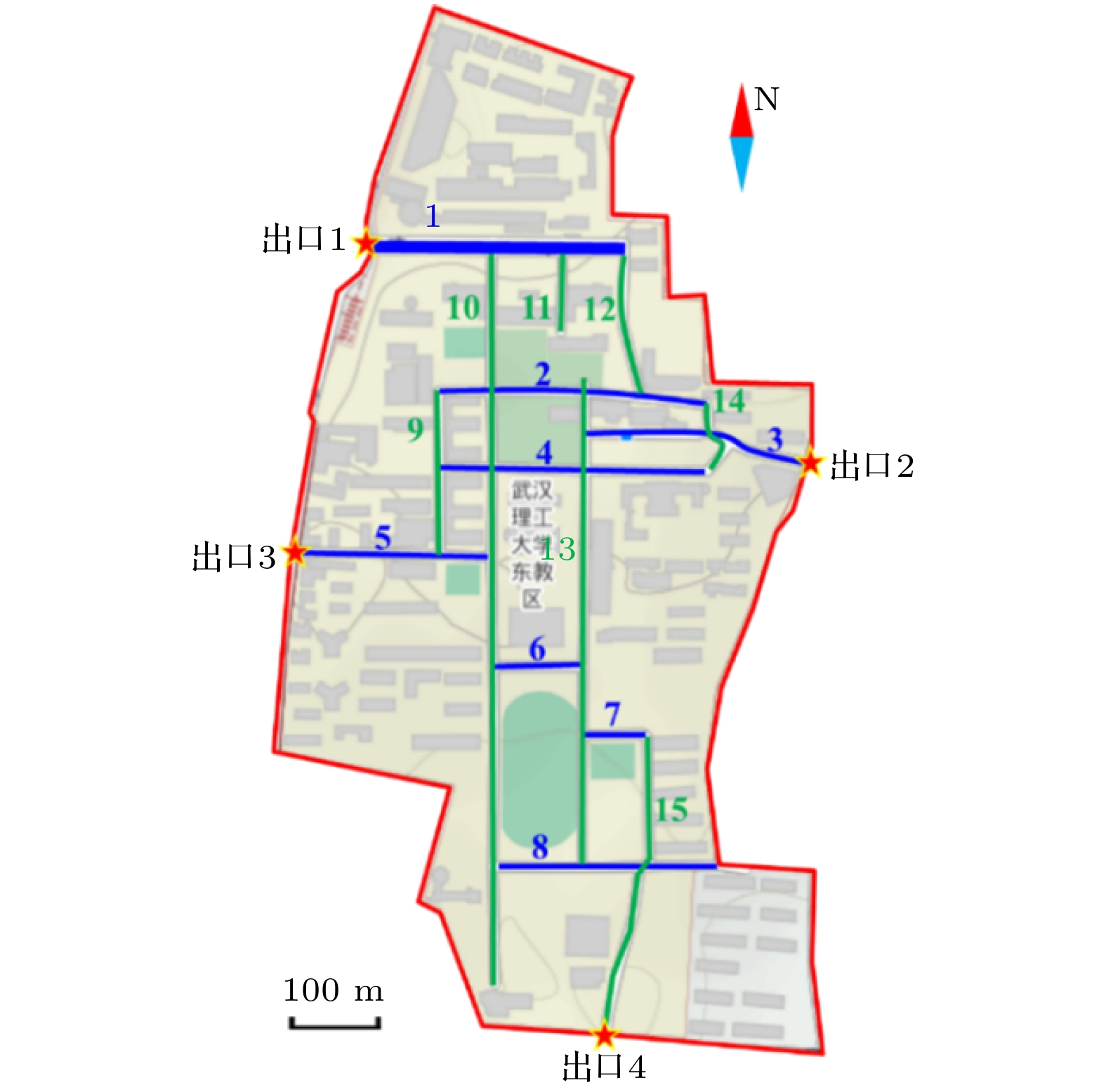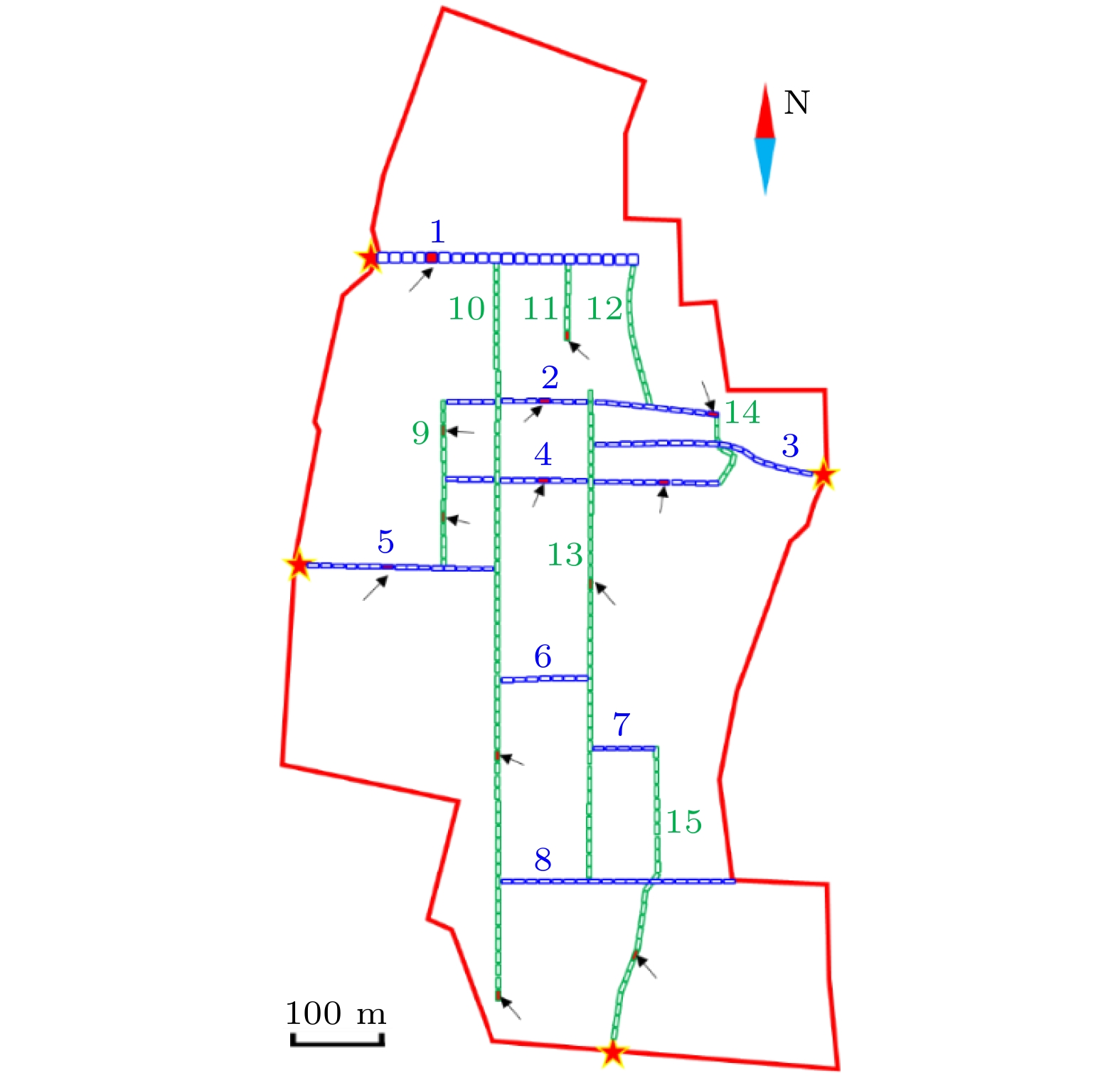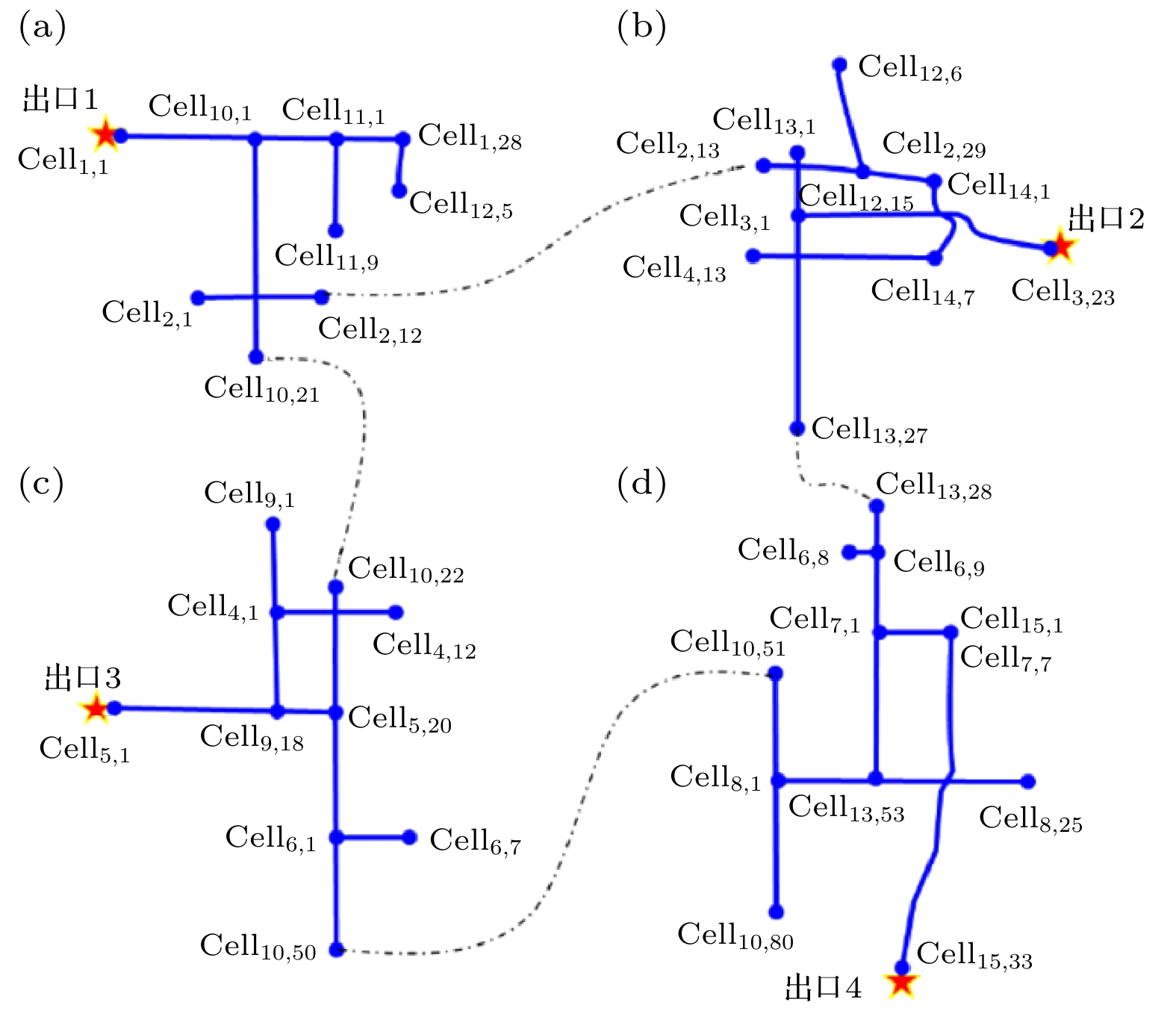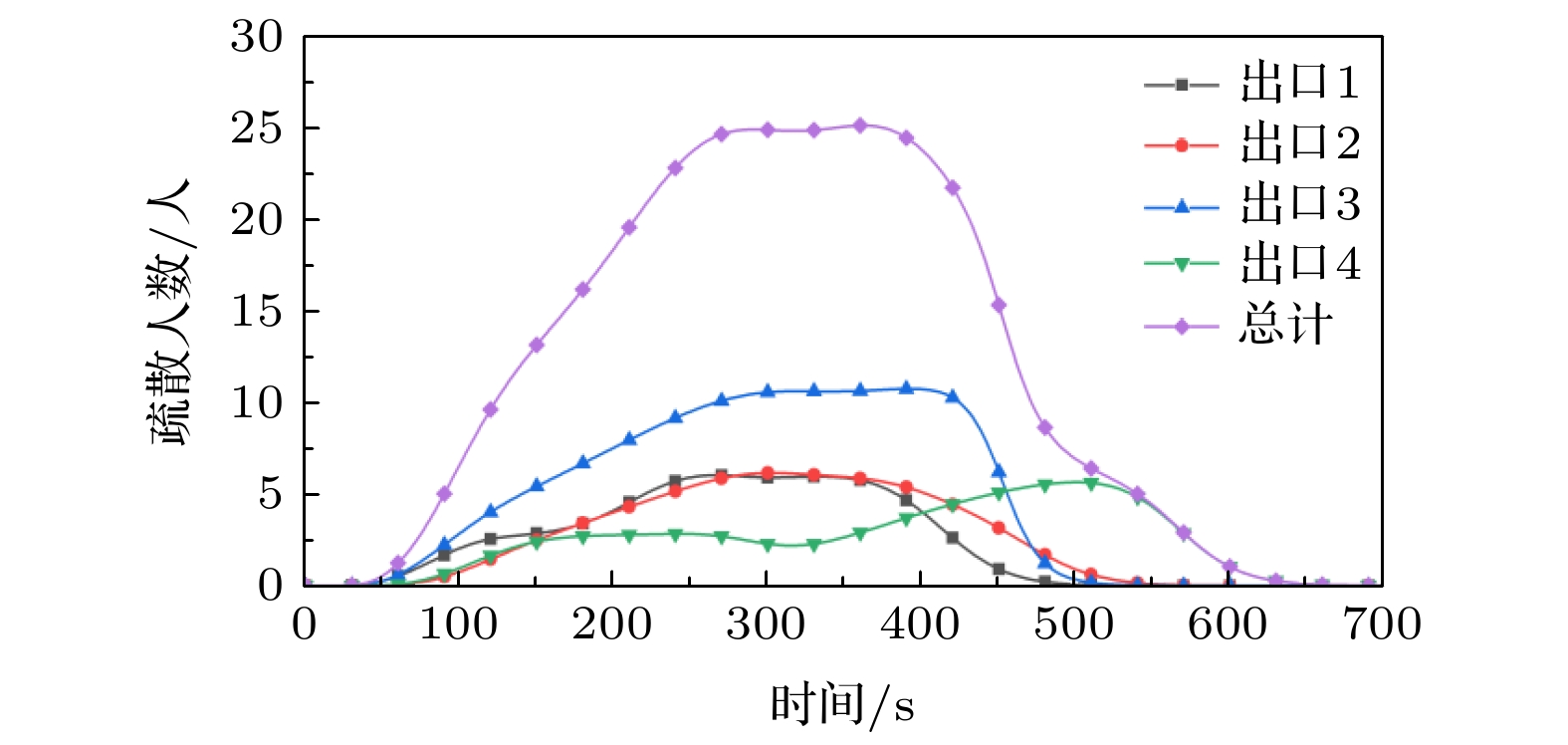-
In the traditional cellular automata evacuation model, the space is divided into fine grids at a micro level, which is mainly used in a two-dimensional plane case. The evacuation space is mostly a small-scale architectural space or local area. Therefore, it is difficult to simulate a wide range of evacuation scenario, and there are less researches of the cellular automata model for a wide range of evacuation. Therefore, this article combines the movement characteristics and status of the pedestrian flow to establish a mesoscopic cellular automata model of evacuation applied to larger evacuation scenarios. This model uses road cell division instead of planar grid cell division, which augments the area of a single cell physically, increases the number of people occupied by a single cell, and expresses the number of people in each cell in the form of state variables. By changing personnel density and personnel speed, and by introducing “source loading” cell loading to simulate the evacuation of people in the scene, the behavior of pedestrians evacuating from the building to the road in the actual evacuation process can be simulated. The state transition equation simulates the movement of people in the evacuation process. When the number of people in the cell is larger, the density of people in the cell is higher, and their walking speed also decreases, which reflects the distribution and movement characteristics of pedestrian flow. This paper uses this model to divide the evacuation area of the college campus, and divides the entire campus into four evacuation areas. The evacuees in each area are evacuated corresponding to the corresponding exit, by planning the evacuation path, pedestrians walking from the “source loading” cell to the exit for evacuation. Through simulation, it is possible to analyze the macro-evacuation situation in the scene and observe the status change of a single cell. There are observed a high density of people in local road sections during campus evacuation, and the problem about the distribution of people on campus problems such as unevenness of pedestrian distribution and long evacuation schedules in certain places. Through the simulation of this model, possible problems in the actual evacuation process are found, and the improvement guidance and opinions are presented correspondingly.
-
Keywords:
- mesoscopic cellular automata /
- large-scale simulation /
- pedestrian evacuation /
- partition evacuation
[1] Miyagawa D, Ichinose G 2020 Physica A 549 124376
 Google Scholar
Google Scholar
[2] Ji J W, Lu L G, Jin Z H, Wei S P, Ni L 2018 Physica A 509 1034
 Google Scholar
Google Scholar
[3] Maniccam S 2003 Physica A 321 653
 Google Scholar
Google Scholar
[4] Leng B, Wang J Y, Zhao W Y, Xiong Z 2014 Physica A 402 119
 Google Scholar
Google Scholar
[5] Jooyoung K, Chiwon A, Seungjae L 2018 Physica A 510 507
 Google Scholar
Google Scholar
[6] Hanisch A, Tolujew J, Richter K 2003 Proc. Winter Simul. Conf. 2 1635
[7] Crociani L, Lämmel G, Park H J, Vizzari G 2017 Transportation Research Board. Annual Meeting of the Transportation Research Board Washington, D.C., USA, Jan, 2017 p1
[8] Lämmel G, Flötteröd G 2015 Proc. Comput. Sci 52 950
 Google Scholar
Google Scholar
[9] Kaji M, Inohara T 2017 Physica A 467 85
 Google Scholar
Google Scholar
[10] Shi M, Lee E W M, Ma Y 2018 Physica A 497 198
 Google Scholar
Google Scholar
[11] 胡俊, 游磊 2014 物理学报 63 080507
 Google Scholar
Google Scholar
Hu J, You L 2014 Acta Phys. Sin. 63 080507
 Google Scholar
Google Scholar
[12] Hu J, You L, Wei J, Gu M S, Liang Y 2014 Phys. Lett. A 378 1913
 Google Scholar
Google Scholar
[13] 张磊, 岳昊, 李梅, 王帅, 米雪玉 2015 物理学报 64 060505
Zhang L, Yue H, Li M, Wang S, Mi X Y 2015 Acta Phys. Sin. 64 060505
[14] 任刚, 陆丽丽, 王炜 2012 物理学报 61 144501
 Google Scholar
Google Scholar
Ren G, Lu L L, Wang W 2012 Acta Phys. Sin. 61 144501
 Google Scholar
Google Scholar
[15] 胥旋, 史聪灵, 李建, 车洪磊 2018 中国安全生产科学技术 14 20
Xu X, Shi C L, Li J, Che H L 2018 J. Saf. Sci. Technol. 14 20
[16] 金泽人, 阮欣, 李越 2018 同济大学学报(自然科学版) 46 1026
 Google Scholar
Google Scholar
Jin Z R, Ruan X, Li Y 2018 J. Tongji Univ. (Nat. Sci.) 46 1026
 Google Scholar
Google Scholar
[17] 陆卓谟, 秦文虎 2011 东南大学学报(自然科学版) 41 1295
 Google Scholar
Google Scholar
Lu Z M, Qin W H 2011 J. Southeast Univ. (Nat. Sci. Ed.) 41 1295
 Google Scholar
Google Scholar
[18] 张维, 郑小平, 程礼盛 2013 电子科技大学学报(社科版) 15 26
Zhang W, Zheng X P, Cheng L S 2013 J. Univ. Electron. Sci. Technol. Chin. (Social Sci. Ed.) 15 26
[19] Cao S C, Song W G, Lü W, Fang Z M 2015 Physica A 436 45
 Google Scholar
Google Scholar
[20] 陈雍容 2012 博士学位论文 (武汉: 华中科技大学)
Chen Y R 2012 Ph. D. Dissertation (Wuhan: Huazhong University of Science and Technology) (in Chinese)
[21] 杨兆升, 高学英, 孙迪 2011 交通运输工程学报 11 114
 Google Scholar
Google Scholar
Yang Z S, Gao X Y, Sun D 2011 J. Traff. Transp. Eng. 11 114
 Google Scholar
Google Scholar
[22] Muramatsu M, Irie T, Nagatani T 1999 Physica A 267 487
 Google Scholar
Google Scholar
[23] Burstedde C, Klauck K, Schadschneider A, Zittartz J 2001 Physica A 295 507
 Google Scholar
Google Scholar
[24] 于彦飞 2008 博士学位论文 (合肥: 中国科学技术大学)
Yu Y F 2008 Ph. D. Disseration (Hefei: University of Science and Technology of China) (in Chinese)
[25] Xu X, Song W G, Zheng H Y 2008 Physica A 387 5567
 Google Scholar
Google Scholar
[26] Ma J, Song W G, Zhang J, Lo S M, Liao G X 2010 Physica A 389 2101
 Google Scholar
Google Scholar
-
表 1 区域道路元胞编码统计信息
Table 1. Statistical information of regional road cellular coding.
道路
编号长/m 宽/m 元胞
数量“源加载”元胞 “出口”元胞 1 280 12 28 Cell1,8 Cell1,1 2 290 6 29 Cell2,9,
Cell2,29— 3 230 6 23 — Cell3,23 4 290 6 29 Cell4,9,
Cell4,17— 5 200 6 20 Cell5,9 Cell5,1 6 90 6 9 — — 7 68 6 7 — — 8 250 6 25 — — 9 180 6 18 Cell9,5,
Cell9,13— 10 795 6 80 Cell10,59,
Cell10,80— 11 90 6 9 Cell11,9 — 12 148 6 15 — — 13 530 6 53 Cell13,21 — 14 70 6 7 — — 15 326 6 33 Cell15,22 Cell15,33 表 2 模型参数
Table 2. Model parameters.
参数 含义 值 l 道路元胞长度 10 m w 道路元胞宽度 6 m vf 自由疏散速度 1.5 m/s $\Delta t$ 计算时间间隔 1 s ρm 拥塞临界密度 5 per/m2 表 3 各“源加载”元胞加载人数
Table 3. The number of pedestrians loaded by each ‘source loading’ cell.
“源加载”
元胞加载总
人数/人“源加载”
元胞加载总
人数/人Cell1, 8 500 Cell2, 9 500 Cell2, 29 500 Cell4, 9 700 Cell4, 17 500 Cell5, 9 900 Cell9, 5 800 Cell9, 13 800 Cell10, 59 600 Cell10, 80 600 Cell11, 9 600 Cell13, 21 700 Cell15, 22 500 表 4 各出口疏散人数
Table 4. Evacuation number at each exit.
出口 疏散总人数/人 出口1 1600 出口2 1700 出口3 3200 出口4 1700 总计 8200 -
[1] Miyagawa D, Ichinose G 2020 Physica A 549 124376
 Google Scholar
Google Scholar
[2] Ji J W, Lu L G, Jin Z H, Wei S P, Ni L 2018 Physica A 509 1034
 Google Scholar
Google Scholar
[3] Maniccam S 2003 Physica A 321 653
 Google Scholar
Google Scholar
[4] Leng B, Wang J Y, Zhao W Y, Xiong Z 2014 Physica A 402 119
 Google Scholar
Google Scholar
[5] Jooyoung K, Chiwon A, Seungjae L 2018 Physica A 510 507
 Google Scholar
Google Scholar
[6] Hanisch A, Tolujew J, Richter K 2003 Proc. Winter Simul. Conf. 2 1635
[7] Crociani L, Lämmel G, Park H J, Vizzari G 2017 Transportation Research Board. Annual Meeting of the Transportation Research Board Washington, D.C., USA, Jan, 2017 p1
[8] Lämmel G, Flötteröd G 2015 Proc. Comput. Sci 52 950
 Google Scholar
Google Scholar
[9] Kaji M, Inohara T 2017 Physica A 467 85
 Google Scholar
Google Scholar
[10] Shi M, Lee E W M, Ma Y 2018 Physica A 497 198
 Google Scholar
Google Scholar
[11] 胡俊, 游磊 2014 物理学报 63 080507
 Google Scholar
Google Scholar
Hu J, You L 2014 Acta Phys. Sin. 63 080507
 Google Scholar
Google Scholar
[12] Hu J, You L, Wei J, Gu M S, Liang Y 2014 Phys. Lett. A 378 1913
 Google Scholar
Google Scholar
[13] 张磊, 岳昊, 李梅, 王帅, 米雪玉 2015 物理学报 64 060505
Zhang L, Yue H, Li M, Wang S, Mi X Y 2015 Acta Phys. Sin. 64 060505
[14] 任刚, 陆丽丽, 王炜 2012 物理学报 61 144501
 Google Scholar
Google Scholar
Ren G, Lu L L, Wang W 2012 Acta Phys. Sin. 61 144501
 Google Scholar
Google Scholar
[15] 胥旋, 史聪灵, 李建, 车洪磊 2018 中国安全生产科学技术 14 20
Xu X, Shi C L, Li J, Che H L 2018 J. Saf. Sci. Technol. 14 20
[16] 金泽人, 阮欣, 李越 2018 同济大学学报(自然科学版) 46 1026
 Google Scholar
Google Scholar
Jin Z R, Ruan X, Li Y 2018 J. Tongji Univ. (Nat. Sci.) 46 1026
 Google Scholar
Google Scholar
[17] 陆卓谟, 秦文虎 2011 东南大学学报(自然科学版) 41 1295
 Google Scholar
Google Scholar
Lu Z M, Qin W H 2011 J. Southeast Univ. (Nat. Sci. Ed.) 41 1295
 Google Scholar
Google Scholar
[18] 张维, 郑小平, 程礼盛 2013 电子科技大学学报(社科版) 15 26
Zhang W, Zheng X P, Cheng L S 2013 J. Univ. Electron. Sci. Technol. Chin. (Social Sci. Ed.) 15 26
[19] Cao S C, Song W G, Lü W, Fang Z M 2015 Physica A 436 45
 Google Scholar
Google Scholar
[20] 陈雍容 2012 博士学位论文 (武汉: 华中科技大学)
Chen Y R 2012 Ph. D. Dissertation (Wuhan: Huazhong University of Science and Technology) (in Chinese)
[21] 杨兆升, 高学英, 孙迪 2011 交通运输工程学报 11 114
 Google Scholar
Google Scholar
Yang Z S, Gao X Y, Sun D 2011 J. Traff. Transp. Eng. 11 114
 Google Scholar
Google Scholar
[22] Muramatsu M, Irie T, Nagatani T 1999 Physica A 267 487
 Google Scholar
Google Scholar
[23] Burstedde C, Klauck K, Schadschneider A, Zittartz J 2001 Physica A 295 507
 Google Scholar
Google Scholar
[24] 于彦飞 2008 博士学位论文 (合肥: 中国科学技术大学)
Yu Y F 2008 Ph. D. Disseration (Hefei: University of Science and Technology of China) (in Chinese)
[25] Xu X, Song W G, Zheng H Y 2008 Physica A 387 5567
 Google Scholar
Google Scholar
[26] Ma J, Song W G, Zhang J, Lo S M, Liao G X 2010 Physica A 389 2101
 Google Scholar
Google Scholar
Catalog
Metrics
- Abstract views: 8075
- PDF Downloads: 144
- Cited By: 0















 DownLoad:
DownLoad:


